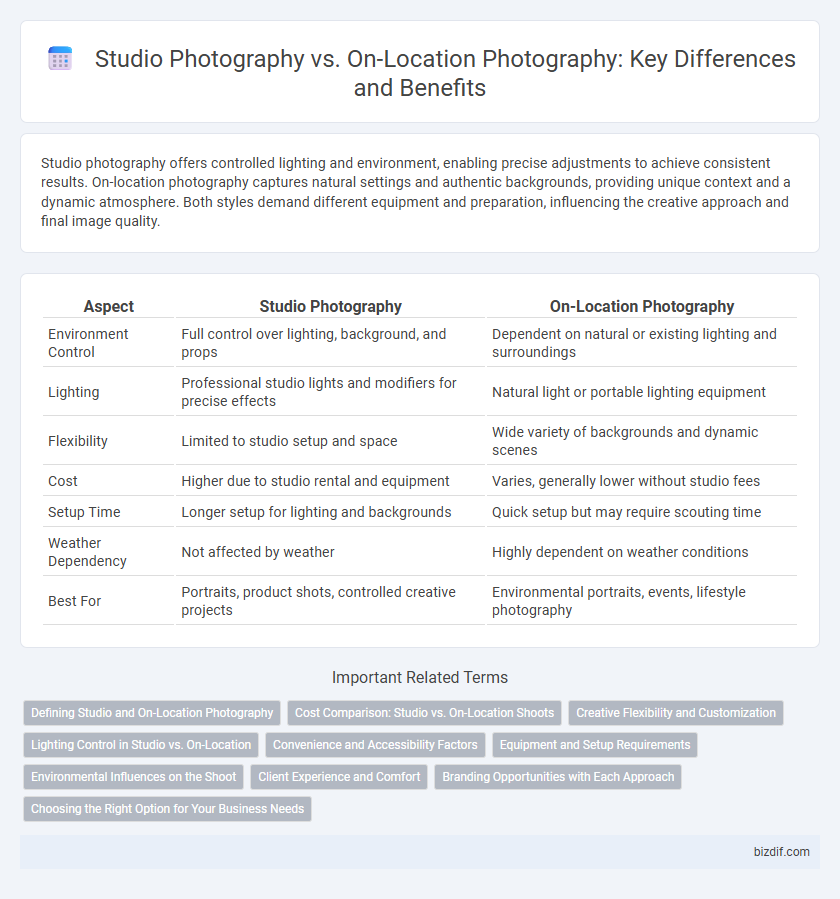Studio photography offers controlled lighting and environment, enabling precise adjustments to achieve consistent results. On-location photography captures natural settings and authentic backgrounds, providing unique context and a dynamic atmosphere. Both styles demand different equipment and preparation, influencing the creative approach and final image quality.
Table of Comparison
| Aspect | Studio Photography | On-Location Photography |
|---|---|---|
| Environment Control | Full control over lighting, background, and props | Dependent on natural or existing lighting and surroundings |
| Lighting | Professional studio lights and modifiers for precise effects | Natural light or portable lighting equipment |
| Flexibility | Limited to studio setup and space | Wide variety of backgrounds and dynamic scenes |
| Cost | Higher due to studio rental and equipment | Varies, generally lower without studio fees |
| Setup Time | Longer setup for lighting and backgrounds | Quick setup but may require scouting time |
| Weather Dependency | Not affected by weather | Highly dependent on weather conditions |
| Best For | Portraits, product shots, controlled creative projects | Environmental portraits, events, lifestyle photography |
Defining Studio and On-Location Photography
Studio photography involves capturing images within a controlled indoor environment equipped with professional lighting, backdrops, and props to manipulate every aspect of the scene. On-location photography takes place at outdoor or real-world sites, leveraging natural light and authentic settings to create more dynamic, context-rich images. Each method offers distinct advantages in terms of creative control, ambiance, and technical requirements for photographers.
Cost Comparison: Studio vs. On-Location Shoots
Studio photography typically involves fixed costs such as rental fees, controlled lighting equipment, and climate control, making budgeting more predictable. On-location photography often incurs variable expenses including travel, permits, and adaptable lighting setups, which can increase overall costs depending on the shoot's complexity. Evaluating these factors helps photographers and clients choose the most cost-efficient option based on project requirements and budget constraints.
Creative Flexibility and Customization
Studio photography offers unparalleled creative flexibility with controlled lighting and customizable backdrops, enabling photographers to craft precise visual narratives. On-location photography provides dynamic, natural environments that inspire spontaneous creativity, though with limited control over lighting and background elements. Each approach balances customization differently, depending on the desired artistic vision and project requirements.
Lighting Control in Studio vs. On-Location
Studio photography offers precise lighting control through adjustable artificial light sources like strobes and softboxes, ensuring consistent illumination tailored to the subject's needs. On-location photography relies on natural light or portable lighting equipment, which can result in variable lighting conditions influenced by environmental factors. Mastery of lighting modifiers and reflectors is crucial in both settings to optimize image quality and achieve the desired aesthetic.
Convenience and Accessibility Factors
Studio photography offers unmatched convenience with controlled lighting, weather independence, and readily available equipment, making it ideal for predictable results and efficient workflow. On-location photography provides unique accessibility to diverse backgrounds and natural settings but may involve logistical challenges such as travel, permits, and variable environmental conditions. Balancing convenience and accessibility depends on project requirements, with studios excelling in controlled environments and locations offering authentic, dynamic visuals.
Equipment and Setup Requirements
Studio photography demands controlled lighting systems, backdrops, and adjustable tripods to create consistent image quality, enabling precise manipulation of shadows and reflections. On-location photography requires portable equipment such as battery-operated flashes, light modifiers, and compact tripods to adapt quickly to varying environmental conditions. Understanding setup flexibility and equipment portability is crucial for photographers to optimize image results in both controlled and unpredictable settings.
Environmental Influences on the Shoot
Studio photography offers complete control over lighting, background, and environmental conditions, enabling consistent and precise image results. On-location photography relies heavily on natural light and surroundings, where weather, time of day, and ambient elements significantly impact the shoot's mood and composition. Understanding environmental influences helps photographers adapt techniques and gear choices to achieve desired visual effects in diverse settings.
Client Experience and Comfort
Studio photography offers controlled lighting and environment, ensuring consistent image quality and minimizing external distractions, which enhances client comfort and confidence during the shoot. On-location photography provides a natural and dynamic backdrop, creating a more relaxed and authentic atmosphere but may introduce unpredictable conditions that impact client ease. Clients often prefer studio settings for privacy and professionalism, while on-location sessions appeal to those seeking personalized and context-rich images.
Branding Opportunities with Each Approach
Studio photography offers controlled lighting and backgrounds, ideal for creating consistent brand imagery that enhances product recognition and visual identity. On-location photography provides authentic environments that can strengthen brand storytelling by showcasing real-world context and lifestyle elements. Combining both approaches diversifies brand content, maximizing appeal across marketing channels and customer touchpoints.
Choosing the Right Option for Your Business Needs
Studio photography offers controlled lighting, consistent backgrounds, and privacy, making it ideal for product shoots and professional portraits, while on-location photography provides authentic environments and natural light that enhance storytelling and brand identity. Evaluating your business goals, budget constraints, and desired aesthetic helps determine the right choice, as studio setups require investment in equipment and space, whereas location shoots demand logistical planning and adaptability. Selecting the appropriate photography style influences client perception, workflow efficiency, and ultimately, your brand's visual impact.
Studio Photography vs On-Location Photography Infographic

 bizdif.com
bizdif.com